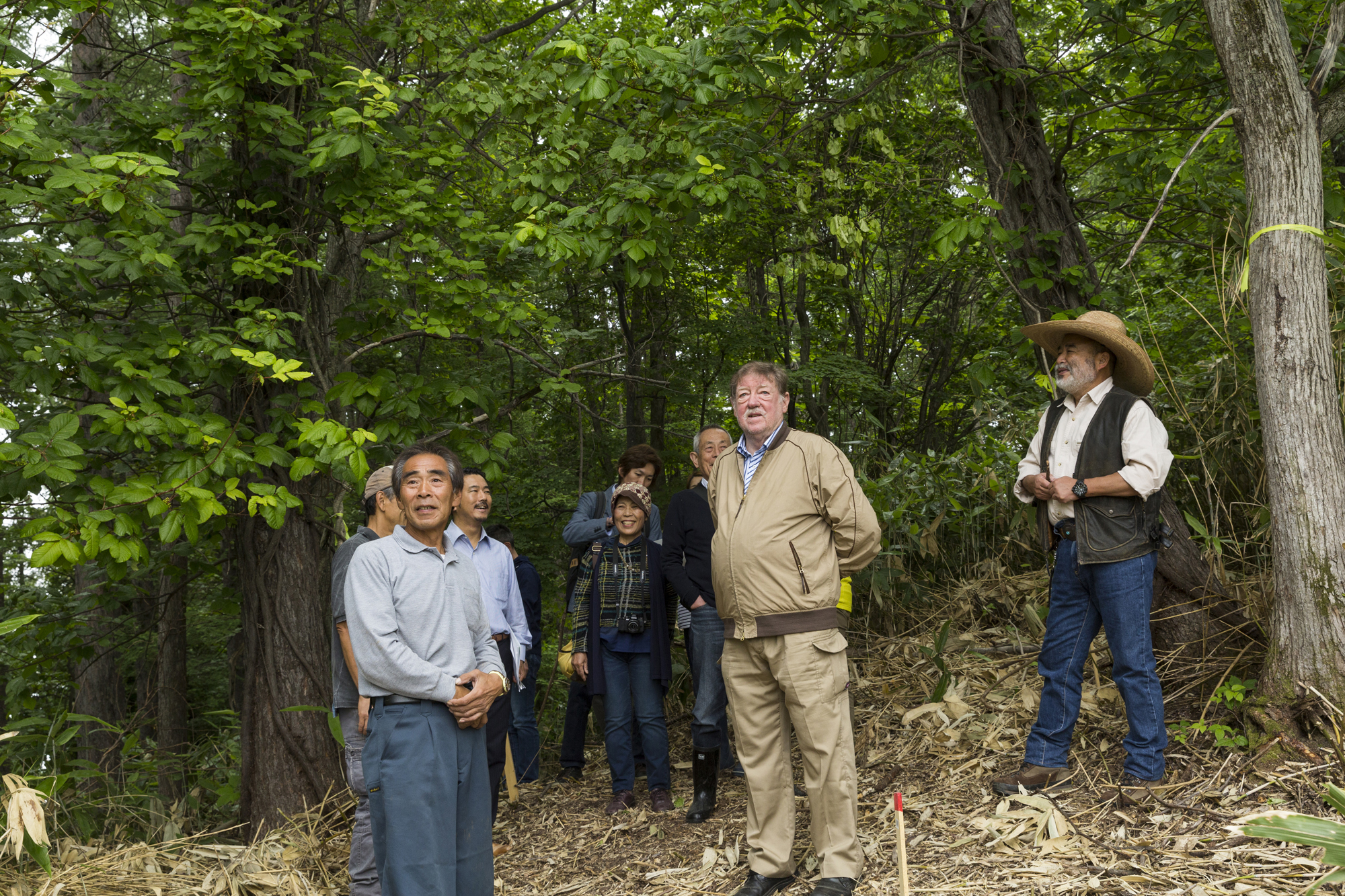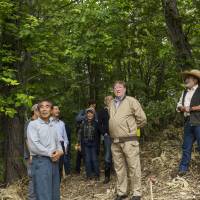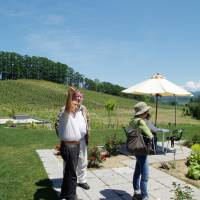The small town of Yoichi in Hokkaido has become famous recently as the setting for much of an NHK TV series titled "Massan" that was screened every day, Monday to Saturday, from September 2014 to March this year.
The popular 15-minute morning drama was based on the life story of Masataka Taketsuru (1894-1979), a Hiroshima sake-brewer's son who sailed to Scotland in 1918 to learn the art of making whisky, married a Scottish girl named Jessie Roberta ("Rita") Cowan, and brought her back to Japan.
In 1934, Taketsuru established the Nikka whisky company — having chosen Yoichi as the ideal place for distilling and maturing fine Scotch-style Japanese whisky (as opposed to "whiskey," a spirit from North America or Ireland).
Now home to about 22,000 people, Yoichi, which is on the southeast of the Shakotan Peninsula facing the Sea of Japan, is easily reached by road from Sapporo about 60 km to the east, or by train from there via Otaru.
Since the early 1980s, I've spent a lot of time in Yoichi, both filming whisky commercials and actually making a couple of barrels myself (courtesy of Nikka). My awareness of the place was centered, for the most part, around the distillery, various local bars and eateries, and the annual salmon run up the Yoichi River, which flows through the town.
Recently, however, I have been looking at the Yoichi area, together with the neighboring township of Niki on the middle stretch of the Yoichi River, through a different lens — one focused on wineries and woodlands.
What is the connection? Well, for a start, to make good wine (or whisky) you need barrels made of oak.
Also, a few years ago I met Kazunori Ishikawa, CEO of the DAC Group which was formed in 1962 from a collection of eight advertising companies and now has, besides its Tokyo headquarters, offices all over Japan and ones in China and Hawaii. Appointed to be CEO in 1977, at the age of 29, Ishikawa states on the company's website how, "In the 21st century, the DAC Group is striving to inspire and to embrace people's happiness to create business and to bring joy to people."
Apart from being an outstanding businessman, Ishikawa is an adventurer who has gone on expeditions all over the globe, including to the Arctic (where I will be, in Canada, when you read this) and Antarctica. He also enjoys good whisky, so we hit it off straight away. Through Ishikawa, I met his friend Kiichiro Ochi, who planted vineyards and established a winery in Yoichi five years ago.
Now, the Occi Gabi Winery is changing the local scenery; all wine producing and storage is underground to protect it from winter snows and avoid it being an eyesore — while above, there's a restaurant, hall and garden. The wine is excellent, as is the food.
Ochi shared his dream with Ishikawa to turn the Niki-Yoichi area into Hokkaido's equivalent of California's famed Napa Valley wine-producing mecca.
When I visited he assured me that 25 percent of the grapes suitable for making wine in Japan are already grown in this area — though at a symposium in which I also took part, he told the audience that Japanese winemaking would be forced to make great changes with the coming of a new law that insists on defining the origins of both grapes and wine. Up until now there has been a lot of fudging. Admittedly there are some pretty good wines in Japan, but many more use imported grape juice and are wishy-washy (to say the least) in taste.
DAC Group has acquired 214,500 sq. meters of land in Niki, amounting to some 21 hectares in all — roughly equivalent to 53 soccer pitches. They have already put in an access road and have excavated for the new wine cellar, an impressive hole in the ground, because that cellar alone will be 100 meters in length. When I was there at the end of June they were pouring concrete. Here too, all wine producing and storage will be underground, with restaurants and facilities above.
At present, about a third of DAC Group's 21 hectares in Niki is covered with dense woodland, much of it comprising spindly conifers. Ishikawa has long been aware of the forest-restoration work we do through my Afan Woodland Trust based in Kurohime, Nagano Prefecture, and I'm delighted to say that he's asked me to be on board with this new Niki Hills Winery project.
The vision for the Niki Hills Winery Woodland is not only to create a haven for wildlife and a buffer to hamper cold winter winds from reaching the vines on lower slopes, but also a place with pleasant paths and places to rest, or to enjoy picnics — with wine, of course.
Meanwhile, part of DAC's land is covered with orchards of mature cherry trees, which when we visited were heavy with the sweetest red cherries I've tasted in a long time. The plan was to cut most of these down to make way for grape vines, but I urged that as many as possible of the healthy, mature trees be left — though I'm well aware that cherry as a fruit here in Japan requires a lot of maintenance.
Fortunately, Ishikawa is very much concerned with helping to conserve and create breathtaking scenery, and he doesn't think that the plastic coverings commonly strung over cherry trees to protect their fruits from birds and other beasties are attractive. So, since he took over, all the aluminum frames and plastic piping has been removed from the orchards, and they did look a lot better.
"I don't mind sharing with the birds," Ishikawa said with a laugh.
During the three days and nights I spent in Yoichi on this last visit, we met with the mayors and officials of both Yoichi and Niki, and held lectures and a symposium for the local people. I also went back to the Nikka whisky distillery to meet old friends and discuss with its current managers when will be the right time for me to brew and distill my third big barrel of single-malt whisky.
However, they said I ought to be around to oversee the bottling in about 12 years' time — so I'd better not hit the hooch too hard between now and then!
But seriously, going back to the Niki Hills Winery Woodland, I am strongly recommending that we replace those conifers as much as possible with a kind of oak known as Quercus crispula (mizu nara in Japanese), a species for which Hokkaido was quite famous in the past.
Over the years, I have personally visited and paid homage to some huge mizu nara oaks that have been protected in other parts of Hokkaido, and which are still strong and healthy at the good old age of 900 years and more. Acquiring acorns and raising saplings from such trees is another task worth doing.
During the Meiji Era (1868-1912), two of Hokkaido's leading exports to the West were canned venison and planks of mizu nara timber — and when Taketsuru began making whisky in Yoichi, it was Hokkaido oak he used for his barrels.
This time, while looking through the Niki woods I found lots of those oaks struggling in the dense brush, but also a few tall and vigorous specimens growing where light was more available on the edges of the forest. And after all, they were one of the dominant original trees — which makes me sure we can bring them back. Who knows, in 100 years or so they might be providing wood for fine barrels.
So you see, wine, whisky and woods have all kinds of links — and it's great fun to be a part of the process.





